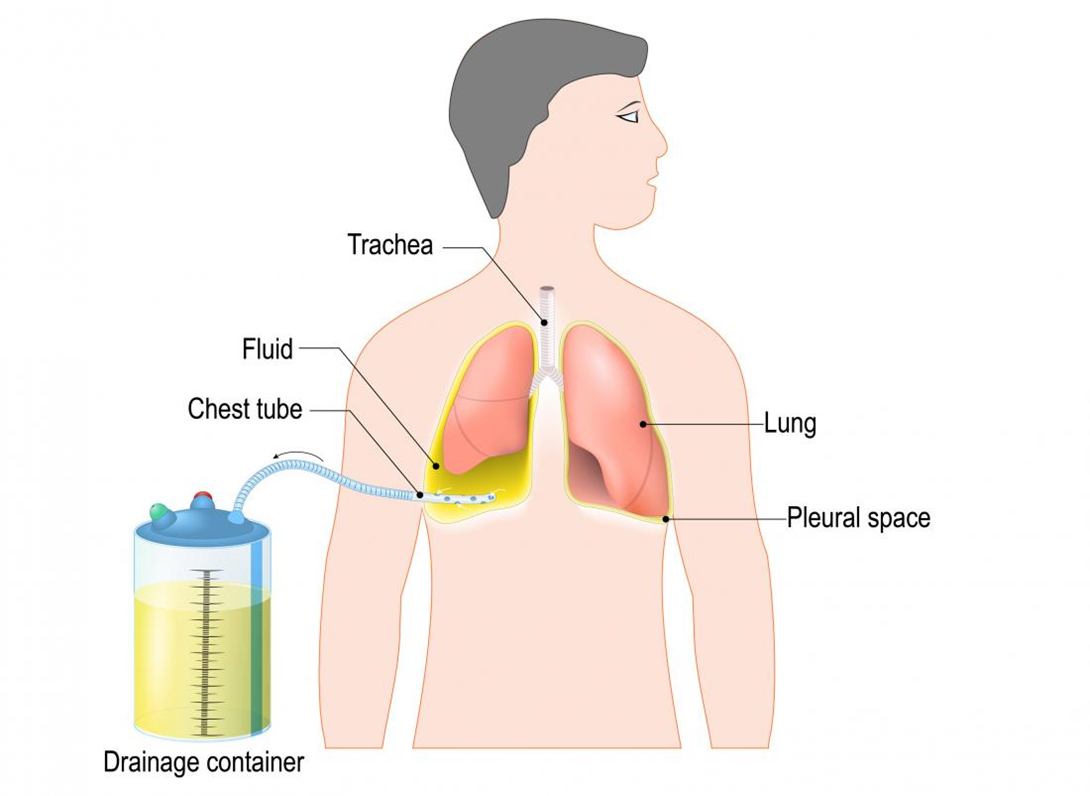Following a motor vehicle accident, a client with chest trauma receives a chest tube to relieve a hemothorax. Two hours following the chest tube insertion, the nurse observes the water level in the water-seal chamber is rising during inspiration and falling during expiration. Which action should the nurse implement?
Lift and clear drainage from the chest tube.
Inspect the tube insertion site for leaking.
Continue to monitor the drainage system.
Auscultate lungs for unequal breath sounds.
The Correct Answer is C
Choice A reason: Lifting and clearing drainage from the chest tube is not necessary, as the water level fluctuations indicate that the chest tube is functioning properly and allowing air and fluid to escape from the pleural space.
Choice B reason: Inspecting the tube insertion site for leaking is not indicated, as there is no evidence of air leak in the water-seal chamber. An air leak would cause continuous or intermittent bubbling in the water-seal chamber.
Choice C reason: Continuing to monitor the drainage system is the best action for the nurse to implement, as the water level fluctuations are normal and expected in a water-seal drainage system. The water level should rise during inspiration and fall during expiration, reflecting the changes in intrathoracic pressure.

Choice D reason: Auscultating lungs for unequal breath sounds is not relevant, as it does not address the question of what to do with the water level fluctuations. Unequal breath sounds may indicate a pneumothorax or atelectasis, which are complications of chest trauma or chest tube insertion.
Nursing Test Bank
Naxlex Comprehensive Predictor Exams
Related Questions
Correct Answer is {"A":{"answers":"B"},"B":{"answers":"A"},"C":{"answers":"A"},"D":{"answers":"A"},"E":{"answers":"B"},"F":{"answers":"A"}}
Explanation
Choice A reason: Place the client in a room near the elevator: This does **not** promote client safety, because it exposes the client to more noise and disturbance, which can increase stress and blood pressure. A quiet and calm environment is preferable for stroke clients.
Choice B reason: Complete a swallow study before giving anything by mouth: This **promotes** client safety, because it assesses the client's ability to swallow and prevent aspiration. Stroke clients may have impaired swallowing due to facial weakness or sensory loss.
Choice C reason: Provide a call button kept within reach: This **promotes** client safety, because it allows the client to communicate their needs and request assistance when needed. Stroke clients may have limited mobility or vision, which can increase their risk of falls or injuries.
Choice D reason: Initiate use of the bed alarm: This **promotes** client safety, because it alerts the staff if the client tries to get out of bed without assistance. Stroke clients may have impaired judgment or balance, which can lead to falls or accidents.
Choice E reason: Place client belongings out of reach: This does **not** promote client safety, because it makes the client feel frustrated and helpless. Stroke clients may have difficulty reaching for their belongings due to hemiparesis or hemiplegia, which can affect their self-care and independence. The nurse should place the client's belongings within reach on their unaffected side and encourage them to use them as much as possible.
Choice F reason: Instruct the client to call before getting up: This **promotes** client safety, because it ensures that the client has adequate support and supervision when getting up. Stroke clients may have orthostatic hypotension, which can cause dizziness or fainting when changing positions. The nurse should assist the client to get up slowly and monitor their vital signs.
Correct Answer is D
Explanation
Choice A reason: This is incorrect because reviewing the need for pneumococcal vaccine is not the most important intervention for the nurse to implement. Pneumococcal vaccine is recommended for people who are at high risk of pneumococcal infections, such as those with chronic diseases or immunosuppression. However, it is not a priority action for a client with neutropenia, which is a low number of neutrophils that increases the risk of bacterial and fungal infections.
Choice B reason: This is incorrect because implementing bleeding precautions is not the most important intervention for the nurse to implement. Bleeding precautions are indicated for clients who have thrombocytopenia, which is a low number of platelets that impairs blood clotting. However, this is not the case for a client with neutropenia, which affects the white blood cells that fight infections.
Choice C reason: This is incorrect because assessing vital signs every 4 hours is not the most important intervention for the nurse to implement. Vital signs are important indicators of the client's health status and may reveal signs of infection, such as fever, tachycardia, or hypotension. However, this is not a sufficient measure to prevent or treat infections in a client with neutropenia, who needs more aggressive and proactive interventions.
Choice D reason: This is correct because placing the client in protective isolation is the most important intervention for the nurse to implement. Protective isolation, also known as reverse isolation or neutropenic precautions, is a set of measures that aim to protect the client from exposure to pathogens that may cause infections. These include wearing gloves, masks, gowns, and eye protection; using sterile equipment and techniques; avoiding contact with people who are sick or have infections; and restricting visitors and fresh flowers or fruits.
Whether you are a student looking to ace your exams or a practicing nurse seeking to enhance your expertise , our nursing education contents will empower you with the confidence and competence to make a difference in the lives of patients and become a respected leader in the healthcare field.
Visit Naxlex, invest in your future and unlock endless possibilities with our unparalleled nursing education contents today
Report Wrong Answer on the Current Question
Do you disagree with the answer? If yes, what is your expected answer? Explain.
Kindly be descriptive with the issue you are facing.
